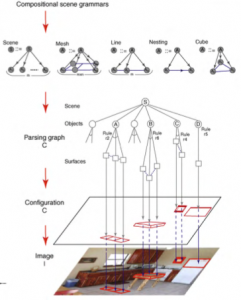I’ve decided to take a closer look at Dennett’s notion of free-floating rationale. It strikes me as being an unhelpful reification, but explaining just why that is has turned out to be a tricky matter. First I’ll look at a passage from a recent article, “The Evolution of Reasons” [1], and then go back three decades to a major exposition of the intentional stance as applied to animal behavior [2]. I’ll conclude with some hints about metaphysics.
On the whole I’m inclined to think of free-floating rationale as a poor solution to a deep problem. It’s not clear to me what a good solution would be, though I’ve got some suggestions as to how that might go.
Evolving Reasons
Dennett opens his inquiry by distinguishing between “a process narrative that explains the phenomenon without saying it is for anything” and an account that provides “a reason–a proper telic reason” (p. 50). The former is what he calls a how come? account and the latter is a what for? account. After reminding us of Aristotle’s somewhat similar four causes Dennett gets down to it: “Evolution by natural selection starts with how come and arrives at what for. We start with a lifeless world in which there are lots of causes but no reasons, no purposes at all.” (p. 50).
Those free-floating rationales are a particular kind of what for. He introduces the term on page 54:
So there were reasons before there were reason representers. The reasons tracked by evolution I have called “free-floating rationales” (1983, 1995, and elseswhere), a term that has apparently jangled the nerves of more than a few thinkers, who suspect I am conjuring up ghosts of some sort. Free-floating rationales are no more ghostly or problematic than numbers or centers of gravity. There were nine planets before people invented ways of articulating arithmetic, and asteroids had centers of gravity before there were physicists to dream up the idea and calculate with it. I am not relenting; instead, I am hoping here to calm their fears and convince them that we should all be happy to speak of the reasons uncovered by evolution before they were ever expressed or represented by human investigators or any other minds.
That is, just as there is no mystery about the relationship between numbers and planets, or between centers of gravity and asteroids, so there is no mystery about the relationship between free-floating rationales and X.
What sorts of things can we substitute for X? That’s what’s tricky. It turns out those things aren’t physically connected objects. Those things are patterns of interaction among physically connected objects.
Before taking a look at those patterns (in the next section), let’s consider another passage from this article (p. 54):
Natural selection is thus an automatic reason finder that “discovers,” “endorses,” and “focuses” reasons over many generations. The scare quotes are to remind us that natural selection doesn’t have a mind, doesn’t itself have reasons, but is nevertheless competent to perform this “task” of design refinement. This is competence without comprehension.
That’s where Dennett is going, “competence without comprehension” – a recent mantra of his.
It is characteristic of Dennett’s intentional stance that it authorizes the use of intentional language, such as “discovers,” “endorses,” and “focuses”. That’s what it’s for, to allow the use of such language in situations where it comes naturally and easily. What’s not clear to me is whether or not one is supposed to treat it as a heuristic device that leads to non-intentional accounts. Clearly intentional talk about “selfish” genes is to be cashed out in non-intentional talk, and that would seem to be the case with natural selection in general.
But it is one thing to talk about cashing out intentional talk in a more suitable explanatory lingo. It’s something else to actually do so. Dennett’s been talking about free-floating rationales for decades, but hasn’t yet, so far as I know, proposed a way of getting rid of that bit of intentional talk. Continue reading “In Search of Dennett’s Free-Floating Rationales”


